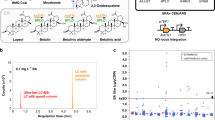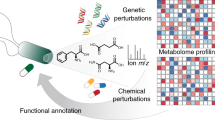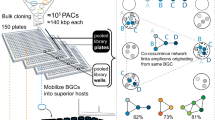Abstract
We present a yeast chemical-genomics approach designed to identify genes that when mutated confer drug resistance, thereby providing insight about the modes of action of compounds. We developed a molecular barcoded yeast open reading frame (MoBY-ORF) library in which each gene, controlled by its native promoter and terminator, is cloned into a centromere-based vector along with two unique oligonucleotide barcodes. The MoBY-ORF resource has numerous genetic and chemical-genetic applications, but here we focus on cloning wild-type versions of mutant drug-resistance genes using a complementation strategy and on simultaneously assaying the fitness of all transformants with barcode microarrays. The complementation cloning was validated by mutation detection using whole-genome yeast tiling microarrays, which identified unique polymorphisms associated with a drug-resistant mutant. We used the MoBY-ORF library to identify the genetic basis of several drug-resistant mutants and in this analysis discovered a new class of sterol-binding compounds.
This is a preview of subscription content, access via your institution
Access options
Subscribe to this journal
Receive 12 print issues and online access
$209.00 per year
only $17.42 per issue
Buy this article
- Purchase on Springer Link
- Instant access to full article PDF
Prices may be subject to local taxes which are calculated during checkout





Similar content being viewed by others
References
Giaever, G. et al. Genomic profiling of drug sensitivities via induced haploinsufficiency. Nat. Genet. 21, 278–283 (1999).
Hoon, S. et al. An integrated platform of genomic assays reveals small-molecule bioactivities. Nat. Chem. Biol. 4, 498–506 (2008).
Rine, J., Hansen, W., Hardeman, E. & Davis, R.W. Targeted selection of recombinant clones through gene dosage effects. Proc. Natl. Acad. Sci. USA 80, 6750–6754 (1983).
Butcher, R.A. et al. Microarray-based method for monitoring yeast overexpression strains reveals small-molecule targets in TOR pathway. Nat. Chem. Biol. 2, 103–109 (2006).
Luesch, H. et al. A genome-wide overexpression screen in yeast for small-molecule target identification. Chem. Biol. 12, 55–63 (2005).
Parsons, A.B. et al. Integration of chemical-genetic and genetic interaction data links bioactive compounds to cellular target pathways. Nat. Biotechnol. 22, 62–69 (2004).
Hillenmeyer, M.E. et al. The chemical genomic portrait of yeast: uncovering a phenotype for all genes. Science 320, 362–365 (2008).
Hughes, T.R. et al. Functional discovery via a compendium of expression profiles. Cell 102, 109–126 (2000).
Parsons, A.B. et al. Exploring the mode-of-action of bioactive compounds by chemical-genetic profiling in yeast. Cell 126, 611–625 (2006).
Douglas, C.M. et al. The Saccharomyces cerevisiae FKS1 (ETG1) gene encodes an integral membrane protein which is a subunit of 1,3-beta-D-glucan synthase. Proc. Natl. Acad. Sci. USA 91, 12907–12911 (1994).
Justice, M.C. et al. Elongation factor 2 as a novel target for selective inhibition of fungal protein synthesis. J. Biol. Chem. 273, 3148–3151 (1998).
Fried, H.M. & Warner, J.R. Molecular cloning and analysis of yeast gene for cycloheximide resistance and ribosomal protein L29. Nucleic Acids Res. 10, 3133–3148 (1982).
Liu, Y.-X., Hsiung, Y., Jannatipour, M., Yeh, Y. & Nitiss, J.L. Yeast topoisomerase II mutants resistant to anti-topoisomerase agents: identification and characterization of new yeast topoisomerase II mutants selected for resistance to etoposide. Cancer Res. 54, 2943–2951 (1994).
Kanik-Ennulat, C., Montalvo, E. & Neff, N. Sodium orthovanadate-resistant mutants of Saccharomyces cerevisiae show defects in golgi-mediated protein glycosylation, sporulation and detergent resistance. Genetics 140, 933–943 (1995).
Heitman, J., Movva, N. & Hall, M. Targets for cell cycle arrest by the immunosuppressant rapamycin in yeast. Science 253, 905–909 (1991).
Wiesen, K.M., Xia, S., Yang, C.-P.H. & Horwitz, S.B. Wild-type class I [beta]-tubulin sensitizes Taxol-resistant breast adenocarcinoma cells harboring a [beta]-tubulin mutation. Cancer Lett. 257, 227–235 (2007).
Douglas, C.M., Marrinan, J.A., Li, W. & Kurtz, M.B. A Saccharomyces cerevisiae mutant with echinocandin-resistant 1,3-beta-D-glucan synthase. J. Bacteriol. 176, 5686–5696 (1994).
Li, M.Z. & Elledge, S.J. MAGIC, an in vivo genetic method for the rapid construction of recombinant DNA molecules. Nat. Genet. 37, 311–319 (2005).
Giaever, G. et al. Functional profiling of the Saccharomyces cerevisiae genome. Nature 418, 387–391 (2002).
Pierce, S.E. et al. A unique and universal molecular barcode array. Nat. Methods 3, 601–603 (2006).
Tong, A.H.Y. et al. Systematic genetic analysis with ordered arrays of yeast deletion mutants. Science 294, 2364–2368 (2001).
Winzeler, E.A. et al. Functional characterization of the S. cerevisiae genome by gene deletion and parallel analysis. Science 285, 901–906 (1999).
Gresham, D. et al. Genome-wide detection of polymorphisms at nucleotide resolution with a single DNA microarray. Science 311, 1932–1936 (2006).
Käufer, N.F., Fried, H.M., Schwindinger, W.F., Jasin, M. & Warner, J.R. Cycloheximide resistance in yeast: the gene and its protein. Nucleic Acids Res. 11, 3123–3135 (1983).
Vézina, C., Kudelski, A. & Sehgal, S.N. Rapamycin (AY-22,989), a new antifungal antibiotic. I. Taxonomy of the producing streptomycete and isolation of the active principle. J. Antibiot. (Tokyo) 28, 721–726 (1975).
Brown, E.J. et al. A mammalian protein targeted by G1-arresting rapamycin-receptor complex. Nature 369, 756–758 (1994).
Chiu, M.I., Katz, H. & Berlin, V. RAPT1, a mammalian homolog of yeast Tor, interacts with the FKBP12/rapamycin complex. Proc. Natl. Acad. Sci. USA 91, 12574–12578 (1994).
Sabatini, D.M., Erdjument-Bromage, H., Lui, M., Tempst, P. & Snyder, S.H. RAFT1: A mammalian protein that binds to FKBP12 in a rapamycin-dependent fashion and is homologous to yeast TORs. Cell 78, 35–43 (1994).
Coval, S.J., Puar, M.S., Phife, D.W., Terracciano, J.S. & Patel, M. SCH57404, an antifungal agent possessing the rare sodaricin skeleton and a tricyclic sugar moiety. J. Antibiot. (Tokyo) 48, 1171–1172 (1995).
Hauser, D. & Sigg, H.P. Isolierung und abbau von sordarin. 1. Mitteilung über sordarin. Helv. Chim. Acta 54, 1178–1190 (1971).
Capa, L., Mendoza, A., Lavandera, J.L., Gomez de las Heras, F. & Garcia-Bustos, J.F. Translation elongation factor 2 is part of the target for a new family of antifungals. Antimicrob. Agents Chemother. 42, 2694–2699 (1998).
Drotschmann, K. et al. Mutator phenotypes of yeast strains heterozygous for mutations in the MSH2 gene. Proc. Natl. Acad. Sci. USA 96, 2970–2975 (1999).
Krepkiy, D. & Miziorko, H.M. Identification of active site residues in mevalonate diphosphate decarboxylase: implications for a family of phosphotransferases. Protein Sci. 13, 1875–1881 (2004).
Schuldiner, M. et al. Exploration of the function and organization of the yeast early secretory pathway through an epistatic miniarray profile. Cell 123, 507–519 (2005).
Muhlrad, D. & Parker, R. Aberrant mRNAs with extended 3′ UTRs are substrates for rapid degradation by mRNA surveillance. RNA 5, 1299–1307 (1999).
Yan, Z. et al. Yeast Barcoders: a chemogenomic application of a universal donor-strain collection carrying bar-code identifiers. Nat. Methods 5, 719–725 (2008).
Bolard, J. How do the polyene macrolide antibiotics affect the cellular membrane properties? Biochim. Biophys. Acta 864, 257–304 (1986).
Arneson, P.A. & Durbin, R.D. Studies on the mode of action of tomatine as a fungitoxic agent. Plant Physiol. 43, 683–686 (1968).
Simons, V. et al. Dual effects of plant steroidal alkaloids on Saccharomyces cerevisiae. Antimicrob. Agents Chemother. 50, 2732–2740 (2006).
Keukens, E.A.J. et al. Dual specificity of sterol-mediated glycoalkaloid induced membrane disruption. Biochim. Biophys. Acta 1110, 127–136 (1992).
Kitagawa, I., Kobayashi, M., Inamoto, T., Yasuzawa, T. & Kyogoku, Y. The structures of 6 antifungal oligoglycosides, stichloroside-a1, stichloroside-a2, stichloroside-b1, stichloroside-b2, stichloroside-c1, and stichloroside-c2, from the sea-cucumber stichopus-chloronotus (brandt). Chem. Pharm. Bull. (Tokyo) 29, 2387–2391 (1981).
Matsunaga, S., Fusetani, N., Hashimoto, K., Walchli, M. & Theonellamide, F. A novel antifungal bicyclic peptide from a marine sponge Theonella sp. J. Am. Chem. Soc. 111, 2582–2588 (1989).
Matsunaga, S. & Fusetani, N. Theonellamides A-E, cytotoxic bicyclic peptides, from a marine sponge Theonella sp. J. Org. Chem. 60, 1177–1181 (1995).
Bewley, C.A. & Faulkner, D.J. Theonegramide, an antifungal glycopeptide from the Philippine lithistid sponge theonella swinhoei. J. Org. Chem. 59, 4849–4852 (1994).
Ott, R.G. et al. Flux of sterol intermediates in a yeast strain deleted of the lanosterol C-14 demethylase Erg11p. Biochim. Biophys. Acta 1735, 111–118 (2005).
Bagnat, M. & Simons, K. Cell surface polarization during yeast mating. Proc. Natl. Acad. Sci. USA 99, 14183–14188 (2002).
Jones, G.M. et al. A systematic library for comprehensive overexpression screens in Saccharomyces cerevisiae. Nat. Methods 5, 239–241 (2008).
Shendure, J. & Ji, H. Next-generation DNA sequencing. Nat. Biotechnol. 26, 1135–1145 (2008).
Kahvejian, A., Quackenbush, J. & Thompson, J.F. What would you do if you could sequence everything? Nat. Biotechnol. 26, 1125–1133 (2008).
Deutschbauer, A.M. et al. Mechanisms of haploinsufficiency revealed by genome-wide profiling in yeast. Genetics 169, 1915–1925 (2005).
Sopko, R. et al. Mapping pathways and phenotypes by systematic gene overexpression. Mol. Cell 21, 319–330 (2006).
Smith, V., Botstein, D. & Brown, P.O. Genetic footprinting: a genomic strategy for determining a gene's function given its sequence. Proc. Natl. Acad. Sci. USA 92, 6479–6483 (1995).
Jorgensen, P. et al. High-resolution genetic mapping with ordered arrays of Saccharomyces cerevisiae deletion mutants. Genetics 162, 1091–1099 (2002).
Rogers, B. et al. The pleiotropic drug ABC transporters from Saccharomyces cerevisiae. J. Mol. Microbiol. Biotechnol. 3, 207–214 (2001).
Rancati, G. et al. Aneuploidy underlies rapid adaptive evolution of yeast cells deprived of a conserved cytokinesis motor. Cell 135, 879–893 (2008).
Dunham, M.J. et al. Characteristic genome rearrangements in experimental evolution of Saccharomyces cerevisiae. Proc. Natl. Acad. Sci. USA 99, 16144–16149 (2002).
Gresham, D. et al. The repertoire and dynamics of evolutionary adaptations to controlled nutrient-limited environments in yeast. PLoS Genet. 4, e1000303 (2008).
Williams, D.E. et al. Dominicin, a cyclic octapeptide, and laughine, a bromopyrrole alkaloid, isolated from the Caribbean marine sponge Eurypon laughlini. J. Nat. Prod. 68, 327–330 (2005).
Butcher, R.A. & Schreiber, S.L. A microarray-based protocol for monitoring the growth of yeast overexpression strains. Nat. Protoc. 1, 569–576 (2006).
Pierce, S.E., Davis, R.W., Nislow, C. & Giaever, G. Genome-wide analysis of barcoded Saccharomyces cerevisiae gene-deletion mutants in pooled cultures. Nat. Protoc. 2, 2958–2974 (2007).
Acknowledgements
We thank A. Smith and L. Heisler for advice on the data analysis of barcode microarray and A. Ward for technical assistance with the YTM experiments. We thank B. Sheikh for primer design, diagnostic digest predictions and sequencing scripts. We thank K. Toufighi for data analysis of liposome leakage experiments. Theonellamide was a kind gift from S. Matsunaga (Graduate School of Agricultural and Life Sciences, The University of Tokyo). L.M. was supported by a Canadian Institutes of Health Research Doctoral Research Award. R.J.A. was supported by a research grant from NSERC. C.N. was supported by NHGRI (MOP-84305). G.G. was supported by NHGRI (MOP-81340). D.B. was supported by NIGMS Center for Quantitative Biology (GM071508) and R01 (GM046406). T.R.G. was supported by National Institutes of Health (GM62637). M.Y. and S.N. were supported by an Energy and Industrial Technology Development Organization (NEDO) project on development of basic technology to control biological systems using chemical compounds. C.B. was supported by Genome Canada through the Ontario Genomics Institute as per research agreement 2004-OGI-3-01 and Canadian Institutes of Health Research agreement number MOP-57830.
Author information
Authors and Affiliations
Contributions
C.H.H. was involved in MoBY-ORF construction, carried out experiments, data analysis and interpretation of cloning drug-resistant mutants, carried out the genetic and cell biological experiments to characterize the MOAs of theopalauamide and stichloroside and wrote the manuscript; L.M. was involved in MoBY-ORF construction and wrote the manuscript; S.L.B. was involved in MoBY-ORF construction, sequencing and functional studies of the MoBY-ORF library, and wrote the manuscript; D.G. carried out all the experiments and data analysis of the YTM experiments, and wrote the manuscript; S.N. carried out all the experiments and data analysis of the in vitro ergosterol binding experiment, prepared fluorescently-labeled theonellamide A, and wrote the manuscript; P.N. carried out experiments and data analysis of the liposome leakage experiments, and wrote the manuscript; J.L.Y.K. provided computational support for MoBY-ORF validation, database construction and sequencing analysis; J.P. purified theopalauamide and stichloroside; C.A.G. purified theopalauamide and stichloroside; R.J.A. purified theopalauamide and stichloroside, and edited the manuscript; G.G. provided data analysis of cloning drug-resistant mutants with MoBY-ORF complementation using barcode microarray, and edited the manuscript. C.N. provided data analysis of cloning drug-resistant mutants with MoBY-ORF complementation using barcode microarray, and edited the manuscript; B.A. edited the manuscript; D.B. was involved in YTM analysis and edited manuscript; T.R.G. provided data analysis of all of the liposome leakage experiments, and wrote the manuscript; M.Y. provided data analysis and interpretation of the theopalauamide and theonellamide results, and wrote the manuscript; C.B. conceived and planned the construction of the MoBY-ORF library, provided data analysis and interpretation of the results, and wrote the manuscript.
Corresponding authors
Supplementary information
Supplementary Text and Figures
Supplementary Figures 1–8, Supplementary Table 5 and Supplementary Methods (PDF 1755 kb)
Supplementary Table 1
Primers and restriction digest results for all MoBY-ORF clones are based on the 1st May 2005 freeze of the S288C genome sequence. (XLS 4992 kb)
Supplementary Table 2
Primers used to amplify the barcode/KanMX4 cassettes. (XLS 74 kb)
Supplementary Table 3
Sequencing analysis of MoBY-ORF library clones. (XLS 1632 kb)
Supplementary Table 4
Functional complementation of temperature-sensitive mutants with MoBY-ORF library clones. (XLS 87 kb)
Supplementary Table 6
Affymetrix TAG4 microarray MoBY-ORF barcode annotation. (XLS 665 kb)
Rights and permissions
About this article
Cite this article
Ho, C., Magtanong, L., Barker, S. et al. A molecular barcoded yeast ORF library enables mode-of-action analysis of bioactive compounds. Nat Biotechnol 27, 369–377 (2009). https://doi.org/10.1038/nbt.1534
Received:
Accepted:
Published:
Issue Date:
DOI: https://doi.org/10.1038/nbt.1534
This article is cited by
-
From beer to breadboards: yeast as a force for biological innovation
Genome Biology (2024)
-
Fit-Seq2.0: An Improved Software for High-Throughput Fitness Measurements Using Pooled Competition Assays
Journal of Molecular Evolution (2023)
-
Evidence that conserved essential genes are enriched for pro-longevity factors
GeroScience (2022)
-
Adaptive laboratory evolution in S. cerevisiae highlights role of transcription factors in fungal xenobiotic resistance
Communications Biology (2022)
-
Marine natural products targeting the eukaryotic cell membrane
The Journal of Antibiotics (2021)



